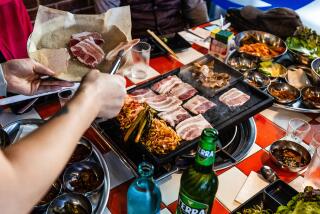Thrill of the Grill
- Share via
Barbecue sauce is the great assimilator of American cooking. It absorbs one ingredient after another, according to the sauce’s time and place, as long as each new splash, dash or drizzle can get along with the rest of the brew. In the early 1800s, the first barbecue sauces, developed in the American South, blended butter and wine with walnut or mushroom “ketchups,” which were really more like savory chutneys. As the art of live-fire cooking spread north and west, from rural barbecue shacks and chuck wagons to city restaurants and suburban backyards, new practitioners catered to their local tastes.
Now we have innumerable versions of red, sticky-sweet, tomato-based sauces; umpteen varieties of brisk vinegar-based sauces; as well as a hodgepodge of garlicky herb or creamy peanut versions, even sauces doctored up with new fascinations including chipotle, papaya and espresso (not all together, please).
Professional pit masters and grilling gurus debate the merits of one sauce versus another the way baseball fans argue for their favorite teams. Personal preference usually comes down to regional loyalties or whatever your dad decided to like, however in researching a barbecue book, I noticed a particular condiment appearing in many top-notch concoctions--soy sauce. I am not talking strictly about Asian barbecue sauces, but rather a rising wave of cross-cultural recipes that rely on small amounts of soy sauce as a potent catalyst for complexity, that actually boosts other flavors and underscores them with deep, savory richness.
The reasons for soy sauce’s dexterity are complicated, lurking in the chemical sciences of its slow fermentation. The process begins when equal parts of soaked, steamed soybeans and ground roasted wheat are inoculated with yeast. This mash is then mixed with saltwater and allowed to stew in stainless steel tanks for several months, sometimes as long as a year. While the soupy, reddish liquid ferments, close to 300 aroma and flavor compounds emerge, ranging from smoky and meaty to earthy and woodsy to tangy and sweet.
A regrettable number of packaged barbecue sauces have little more to offer than corn syrup and vinegar laced with tomatoes, spices and liquid smoke. Most respectable sauces made at home (and some of the better bottled varities) also juxtapose sweet and sour, but they bridge the extremes with a touch of soy sauce, which tones them down. Even more importantly, soy sauce enhances other flavors and fills in empty holes with its well-stocked pantry of fermented compounds.
In the end, good barbecue is about inexplicable synergies. When fire, food and time coalesce just right, even cheap meat, like a chicken wing, offers a rich reward. Barbecue sauce is a critical player in the transformation, but not when it merely clings to the surface with simplistic flavors. The sauce requires a mysterious something that can seep into meat and beguile us. For me, that something is often soy sauce.
*
Chicken Wings with Red Chile Barbecue Sauce
Serves 4-6
4 dried pasilla chiles, about 1 ounce total
Canola oil
1/2 cup ketchup
3 tablespoons soy sauce
2 tablespoons balsamic vinegar
1 tablespoon light brown sugar
3 medium garlic cloves, crushed
1/2 teaspoon ground cumin
1/2 teaspoon dried oregano
1/4 teaspoon kosher salt
1/4 teaspoon freshly ground black pepper
3 pounds chicken wings, tips removed
Remove the stems and cut the chiles crosswise into sections about 2 inches long. Remove most of the seeds. In a medium skillet, warm 2 tablespoons of oil over high heat. Add the chiles carefully (the oil might splatter) and toast them until fragrant, 1 to 2 minutes, turning once.
Transfer the chiles and oil to a small bowl. Cover with 1 cup of hot water. Use a smaller bowl or plate to submerge the chiles. Soak the chiles for 30 minutes. Pour the chiles and water into a blender or food processor. Add the ketchup, soy sauce, vinegar, sugar, garlic, cumin, oregano, salt, and pepper. Process until smooth.
Place the chicken wings in a medium bowl and cover with the chile mixture. Cover the bowl with plastic and refrigerate for 2 hours.
Grill directly over medium heat for 15 to 20 minutes, turning occasionally. Let cool for a few minutes. Serve warm.
More to Read
Eat your way across L.A.
Get our weekly Tasting Notes newsletter for reviews, news and more.
You may occasionally receive promotional content from the Los Angeles Times.










